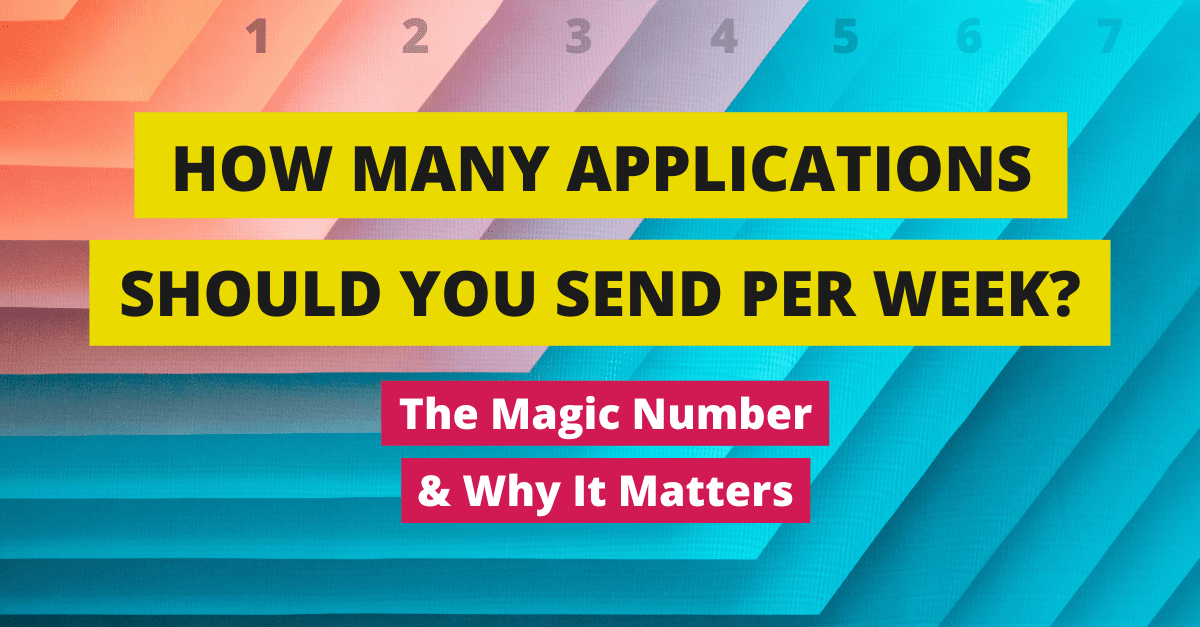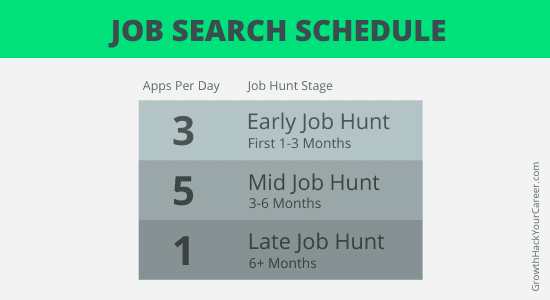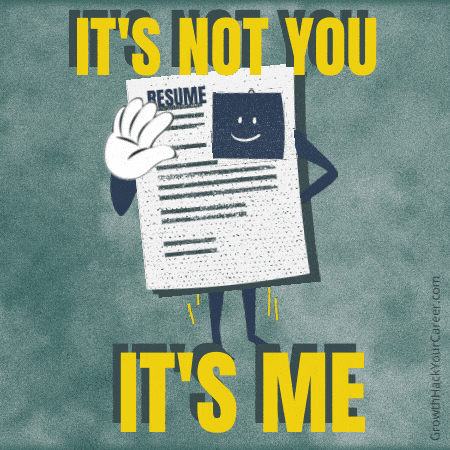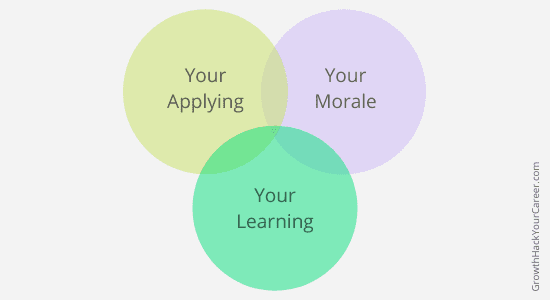
How Many Applications Should You Send (per week) to Get a Job? Here's the Magic Number & Why it Matters
In 2016 I had one of the most depressing years of my life. I had broken up with the girl I thought I was going to marry. I had moved to a brand new city where I didn’t know anybody. And the cherry on my sad cake? I was applying to jobs.
I won’t tell the whole story (you can read about it here), but *spoiler alert* in the end I managed to fall in love again, make new friends, and yes you guessed it, land my dream job.
Today, I want to talk about one of the most important lessons I learned from that experience and that’s this:
Yes, it’s possible to apply both to TOO MANY and to TOO FEW jobs.
Figuring out how many job applications to send is a delicate balance between pushing yourself and fighting burn out.
In this post, I’ll share:
👉 How many applications you should send depending on where you are in your job search journey.
👉 I’ll also share some wisdom from some other career coaches who have taught me a thing or two about job search.
👉 And finally, I’ll leave you with a formula for how to determine how many applications you should aim for.
So, let’s jump right into it!
The Dangers of applying for TOO FEW jobs
According to various job search surveys, the average job search takes 4-8 months. Depending on the level of your role, it may take you shorter or longer.
It also may take you longer if you’re trying to make a career change. When I was trying to make my career change, it took me 14 months to land my first part-time job (but more on that later).
One of the most common mistakes job seekers make is that they don’t apply to enough jobs at the beginning of their job search. A common phrase I hear from job seekers is:
“I’m going to be intentional about my job search and really take my time to find the perfect fit this time.”
☝️ This sounds great...but it’s a trap.
Don’t get me wrong, being intentional about your job search is absolutely a good idea, BUT it is not an excuse to send out one application per week.
There is a difference between being intentional and being picky/lazy.
Being intentional means that you’ve spent time thinking about what you want to do, the type of environment you want to work in, and what your non-negotiables are.
This is entirely separate from the actual application process.
You should absolutely set your intentions, but then you should stick your but in that chair and start applying daily.
I’ve held over 11 jobs in my professional career and what I’ve learned is that it’s pretty much impossible to tell if you’ll work well with a company until you actually start working with them.
This is largely because, just like job seekers, companies tend to “fudge” the facts on their company pages. Does any of this ring a bell:
“We have a great culture here... Everyone is very supportive... We believe our employees are our greatest asset… We give unlimited PTO… There’s a lot of room for growth…”
Sometimes these things are absolutely true, but it’s very difficult to know based on online research. This is why doing informational interviews with current employees is so important. You can learn more about informational interviews from this excellent post by Sarah Johnston.
Although I think informational interviews are valuable, I know from experience that they can really slow down your job hunting process.
This is why my preferred approach is to apply to more companies quickly so I can get into the interview process quickly.
So what’s the ideal number of applications you should send per week to land a job?
The answer is...25 🎉
But stick around, because there’s more to it than that.
The Dangers of applying for TOO MANY jobs
The second most common mistake that job seekers make is applying to too many jobs.
Now, you might be asking, “but Bogdan, job searching is a numbers game. Why wouldn’t more be better?”
It’s true, job searching is a numbers game, but it’s also more than that...
When I was 24 I used to go to the gym twice a week. One week, my friend who had just come home from the Marines decided to join me for my workouts.
He was a super fit guy and did higher weight and more reps than me on pretty much everything. He would frequently yell at me while I did my exercises:
"Come on! You can do 5 more reps! Push yourself!”
Sometimes I would try to do more, but often I would just do my usual weight and repetitions and say, “that’s plenty for today.”
I remember him saying, “you know Bogdan, you’ll never make progress if you don’t push your limits.”
Can you guess where this is going?
A few months after we began working out together, my friend stopped coming to the gym.
Meanwhile, I haven’t missed more than 3 weeks of gym sessions in the last 13 years.
Over that time, I’ve passed pretty much all my humble fitness goals. My friend, on the other hand, has lost his Marine physique and is now 60 pounds heavier and can’t even go for a short jog.
The moral of the story is that too much can be just as bad as too little.
If you’re going to make it through that 4-8 month job search, you’ll need to keep your morale up.
Science shows that accomplishing our goals, even if they’re smaller, actually leads to more success than pushing ourselves to our maximum capacity.
This is why it’s important not to apply to too many jobs per week.
At a certain point, it can just become self destructive. One of my favorite career coaches, Jess Smith, describes this perfectly in this video on “application blasting:”
The Perfect Job Application Schedule
So, as promised, let me explain what I believe is the perfect job application rate and why. Keep in mind that this isn’t set in stone, so feel free to adjust this to your particular situation.
This is, however, what I’ve found works best:

Early Job Hunt
First, you’ll notice that I recommend applying to fewer jobs at the beginning of your job search than at the later stages. This is because at the beginning of your job search process you won’t really know what’s working and what isn’t.
Imagine that you send out 100 job applications in your first week. But, what if you have a flaw in your resume?
Maybe it’s not optimized for Applicant Tracking Systems (ATS) or maybe the bullet points you thought were amazing are actually confusing?
That means you’ve just burned 100 possible opportunities with a sub-par resume. You won’t know until you get some replies.
That’s why at the beginning of a job search I always recommend you start off with 3 applications per day. It gives you enough time to do your research, but not too much time so that you fall into paralysis by analysis.
Of course, you could expedite this process by learning the best practices first through something like our Accelerated Resume Course, but more on that later.
Mid Job Hunt
After you’ve gotten into the groove and you’re getting some replies to your applications, you can up your application rate to 5 applications per day.
I recommend 5 applications per day because it will allow you to submit a completely customized resume and cover letter for each application.
This helps prevent the “application blasting” pitfall that Jess talked about.
IMPORTANT: Once you submit your 5 applications for the day, stop applying! You’re done for the day! This is crucial so that you feel like you had a productive day and is vital to your morale. Trust me, if you keep sending out applications you’ll start feeling demoralized and burn out much faster.
Late Job Hunt
After several months of job hunting, if you’re still not landing interviews, it’s time to take a pause. If you’ve sent out over 200 applications with fully customized and optimized resumes, you should be landing interviews.
If that’s not happening for you, don’t despair. It’s not you, it’s most likely your resume.

There are two options at this point: 👇
- You can get a career coach to help diagnose what you might be doing wrong. There are many career coaches who are worth their weight in gold (luckily they don’t charge that much!). Here is a list of the top 11 Resume Writers I recommend and their prices.
- You can take a more self-guided approach by taking a course to improve your resume writing and interview skills. I’ve spent over 5 years building our Accelerated Resume Course and Interview Course and they’re both included for FREE with your membership.
Either of these two approaches can work, but it’s important that you seek out help at this point. As the saying goes, “the definition of insanity is trying something over and over again expecting a different result.”
Takeaways and Next Steps
The key to succeeding at your job search is to balance these three activities:

Each one of these is necessary, but each one also contains a trap that you can fall into.
For example, learning new skills can help you with your job search. But, if you spend all your time getting certifications while avoiding actually applying to jobs, your job search won’t go anywhere.
Similarly, if you just apply to jobs all day, without learning best practices, your morale will suffer until you give up completely.
As with most things in life, balance is the key to success when it comes to your job search.
Read more resume, LinkedIn, and interview best practices on The GHYC Blog.
Get 1-on-1 Help
Need to land your job ASAP? Fast forward your job search with some 1-on-1 help! 👇
More from the blog:

Best Resume Builders of 2023 (Pros & Cons + Prices)
Modern resume builders use AI, ATS-friendly templates, and active recommendations to help you build your perfect resume faster than ever before. In this post we’ve rounded up the 5 best resume builders of 2023.
How to Beat the ATS in 25 Minutes | The Ultimate Guide
In this guide I’ll show you how to beat the ats (applicant tracking system), plus I’ll give you 2 ATS-friendly resume templates and a free tool to test if your resume is ATS-friendly.
Like this? Try our free courses!
Tired of sending your job applications into a black hole and never hearing back? Get hired faster with our guided courses all for FREE!
Bogdan Zlatkov is the Founder of GHYC and author of "The Ultimate Guide to Job Hunting", ranked #1 on Google. He has been featured in the Wall Street Journal, Fast Company, HR Dive, and more. At GHYC, Bogdan creates job search courses & tools by working with award-winning career coaches, best-selling authors, and Forbes-Council members. Prior to GHYC, Bogdan led the content programs at LinkedIn Learning.